Engineered Wood vs Solid Wood – Which is Better?

Highclere Biscotti Oak
In this article, we’re going to be discussing what is the difference between engineered and solid wood flooring and which is the better choice for you and your home.
However, before we begin, it’s worth clearing up a common misconception – engineered wood flooring is not the same as laminate flooring.
Laminate flooring typically has an HDF core (High-Density Fibreboard), is between 6 to 12mm thick, and has a printed wood-effect paper on the top to make it look like the real thing.
So what is the real thing? The real thing smells like wood, feels like wood, looks like wood, and performs like wood because that’s exactly what it is! Sometimes known as hardwood flooring this can be a solid wood or engineered wood product.
Article Overview
- What is solid wood flooring
- What is engineered flooring
- Which is more stable
- Which is more durable
- Which is more sustainable
- Which looks better
- Which is more expensive
- Which is easier to install
- Conclusion
What is solid wood flooring?
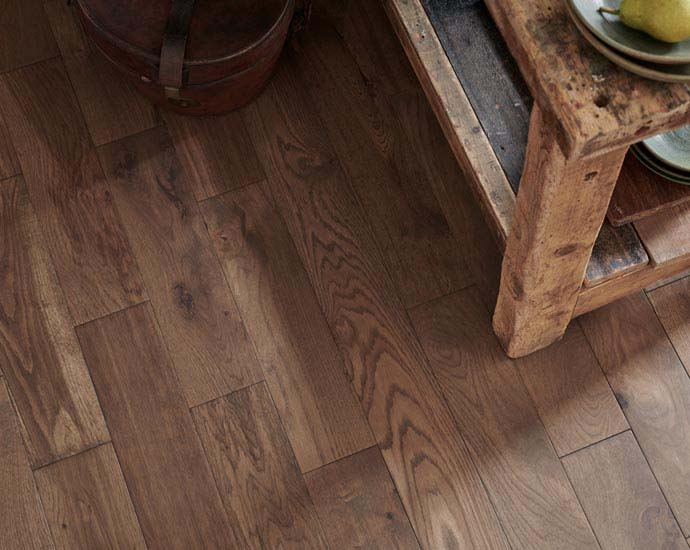
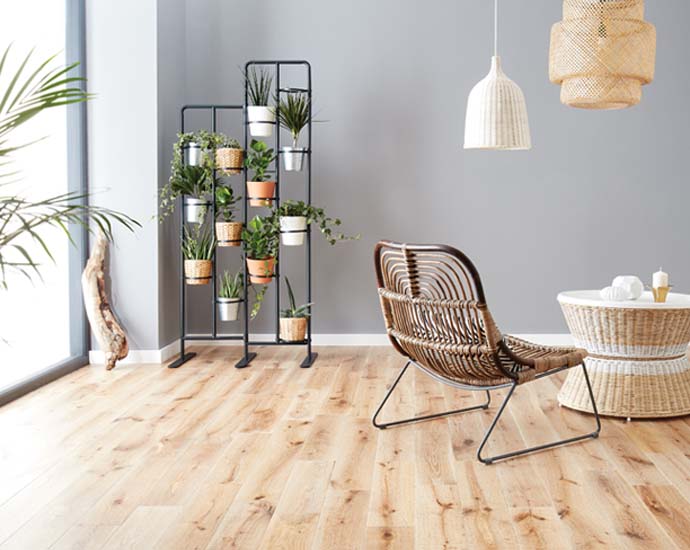
In short, solid wood flooring is a plank of wood that has been milled from one single part of the tree. This can be referred to as solid hardwood flooring or simply solid wood. Read our article which covers FAQs about solid wood flooring if you want to learn more.
What is engineered flooring?

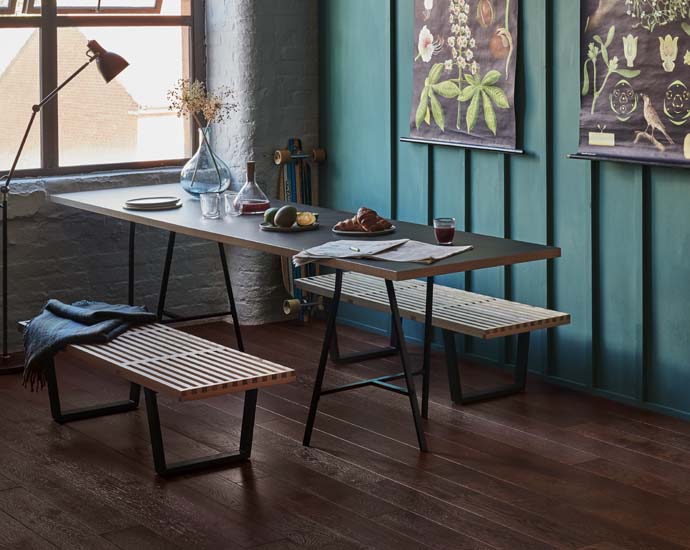
Engineered wood flooring has a real wood top layer and a central core of cross-layered plywood or softwood, and is underpinned with a veneer layer for balance. This can be referred to as manufactured wood flooring, however, the most common name is engineered, or real wood engineered flooring. Read our blog to find out everything you need to know about engineered flooring for more information.
Which is more stable – Solid or engineered wood?
Wood is a natural material that is susceptible to moisture and atmospheric conditions, and that is true with any real wood flooring product too. However, solid hardwood flooring tends to expand and contract more easily to changes in temperature, whilst engineered is more stable and has a better resistance to temperature changes. However, we should add that engineered floors will still be impacted by temperature changes and they are not a waterproof solution.

Additionally, solid wood floors generally come in random lengths ranging between 300mm to 1500mm with the board width around 150mm. The reason for this is stability. The longer and wider a solid plank is, the less stable it is. The same is not true for engineered flooring as it has the central cross-core layer and an underpinned veneer layer, too. This is why it is more common to get wider and longer planks with engineered floors.
The advanced construction of engineered wood flooring minimises expansion, contraction, and warping, and makes these beautiful boards suitable for modern-day living, including underfloor heating. Solid wood floors are not recommended to pair with underfloor heating, which means that if you are planning to use an underfloor heating system, it would be recommended that you consider an engineered hardwood floor over a solid.
Which is more durable – Solid or engineered flooring?

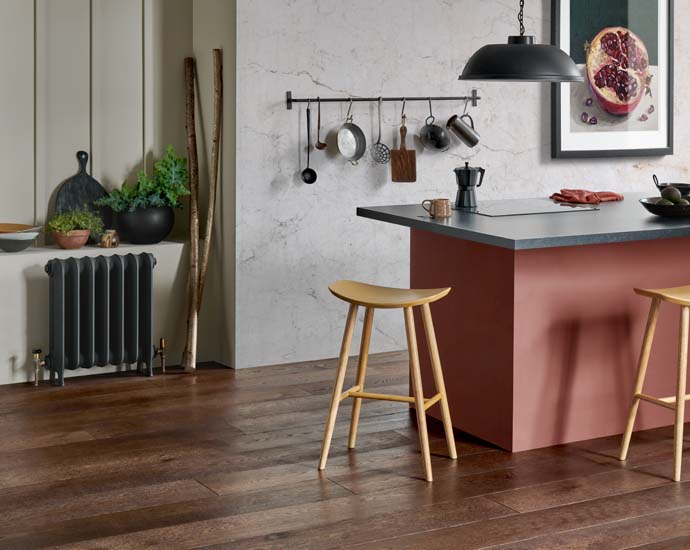
There are the two sides of the coin aspect here. Some people affirm solid hardwood flooring is more durable because it can be refinished multiple times, however, it all depends on what engineered flooring you are comparing it to.
Solid is often perceived as the better product than engineered because it’s solid oak from top to bottom. ‘I can sand it down more often’ or ‘It will last longer’ are often-heard statements.
To break it down in terms of durability, if you compare a solid wood floor with a 6mm wear layer engineered wood floor, the conclusion is that they are both equally durable.
The top oak layer on engineered flooring is available in varying thicknesses from 1.5mm to 6mm (often referred to as the wear layer)
- A 1.5mm wear layer is typically a replaceable floor. After this floor is installed, it can’t be refinished. If the floor gets damaged, it will need to be replaced.
- A 3mm wear layer can usually be refinished once but the flooring contractor would have to be careful. Our Salcombe collection is the perfect place to learn more.
- A 4mm wear layer can typically be refinished up to two times during the lifespan of the floor. If you are feeling adventurous, our Goodrich collection has some beautiful parquet. For planks, the Berkeley and Harlech collection are always up to the task of transforming your space.
- A 6mm wear layer can be refinished as many times as a solid floor which is why our Chepstow range is a popular choice.
Which is more sustainable – Solid or engineered wood flooring?
Whilst solid wood flooring may give the impression that because it seems like it is less manufactured, it is more sustainable, that may not actually be the case.
Engineered flooring does require additional work to create the board, however, in terms of how far the tree goes, engineered flooring helps make the tree go much further. One plank of solid wood flooring could provide the wear layer to multiple engineered boards (depending on their wear layer).

However, always make sure that whichever choice you go with is FSC certified to ensure that the wood is responsibly sourced.
What looks better – solid or engineered flooring?
The only visual tell tale is that solid wood planks will generally be random lengths and shorter than engineered whereas engineered will be mostly similar length planks and usually longer than a solid wood plank. Therefore, if you want to achieve a more contemporary look, a wider and longer plank is what you want to focus on, this will also help make your room look bigger.
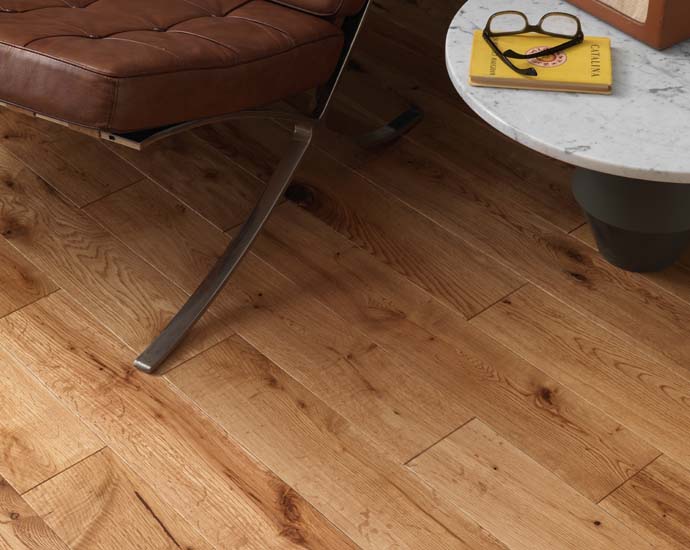

Engineered flooring comes in many forms. Planks vary in size from small parquet and herringbone (such as our Goodrich range) to long and wide boards. This could go as wide as 300mm wide and 3m long. When choosing your floor, consider what will look right in the room you’re thinking of upgrading.
Which is more expensive – Solid or engineered?
When comparing pre-finished quality engineered flooring and pre-finished solid flooring, engineered tends to be more expensive.
However, there are several factors to consider including the work that’s gone into producing the floor particularly those with more character (hand-scraping, distressing, tumbling, smoking, etc), the grade, the wear layer, the size of plank, and so on. It is best to narrow down your requirements, then your favourites, and finally what fits your budget.
Which is easier to install – Solid or engineered wood?
Solid wood flooring is either glued down or nailed down (if over a timber subfloor). Expansion gaps must be considered around the perimeter – in areas over 5m in width, extra provision should be made.
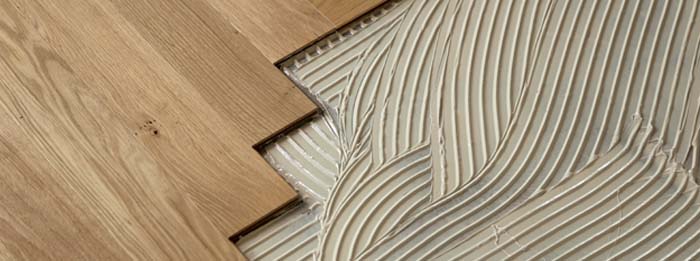
Engineered wood flooring can be glued down (recommended method for underfloor heating), nailed down (if over a timber subfloor), or laid over an underlay and ‘floated’. Again, expansion gaps must be considered around the perimeter although you can go a bit further with engineered due to its stability – in areas over 8m in width, extra provision should be made.
Before installing any floor, the subfloor needs to be sound and flat (see our detailed fitting instructions for more information). If the area is uneven – such as old floorboards, you’ll need a plywood overlay to cover these prior to installing your new floor. If you’ve got a cement subfloor, it may require leveling with a self-leveling compound.
Conclusion – which is best, solid or engineered?
All in all, solid and engineered floors are both excellent choices if you want a real wood floor that will last for decades. However, there are some limitations with solid wood flooring such as how it can be laid (it cannot be floated), it can be more vulnerable to temperature changes (meaning that it may be more likely to cup, warp and/or gap), and the plank lengths are usually much shorter (due to stability and product availability).
Whereas, engineered flooring has all the benefits of solid wood flooring, plus many more (such as being very durable, suitable for underfloor heating and available in a range of widths/lengths). In fact, the only real downfall with engineered flooring is that generally, you can refinish a solid wood floor more than engineered, however, if you look after your engineered wood floor well and follow maintenance advice, then you shouldn’t need to sand it down too often.
Therefore, the choice is completely yours and you should make the decision based on what is right for you and your requirements, but have peace of mind that both are long-lasting flooring solutions that will add beauty and charm to any room. We recommend ordering a sample of each so you can see the board construction and compare the two if you’re still unsure about which is right for you.
Subscribe to our Inspiration Journal for monthly style, trends, and news updates, or follow us on Instagram to see gorgeous interiors right on your feed.
